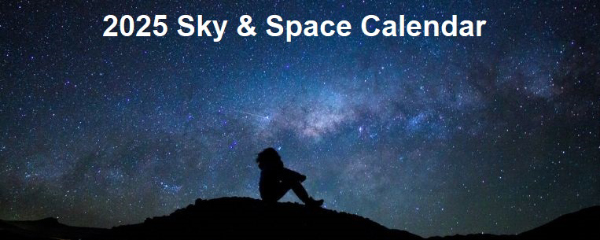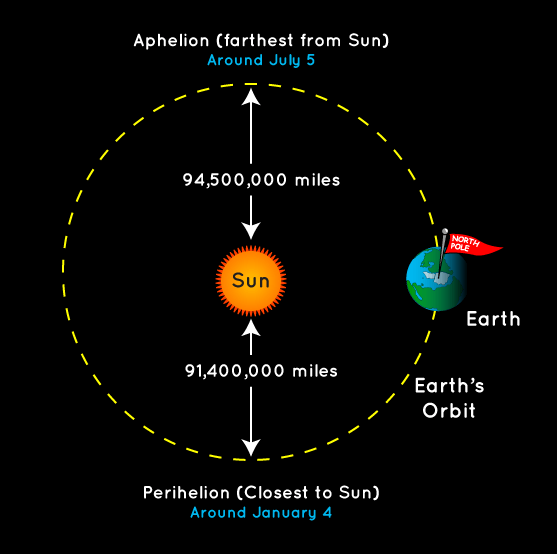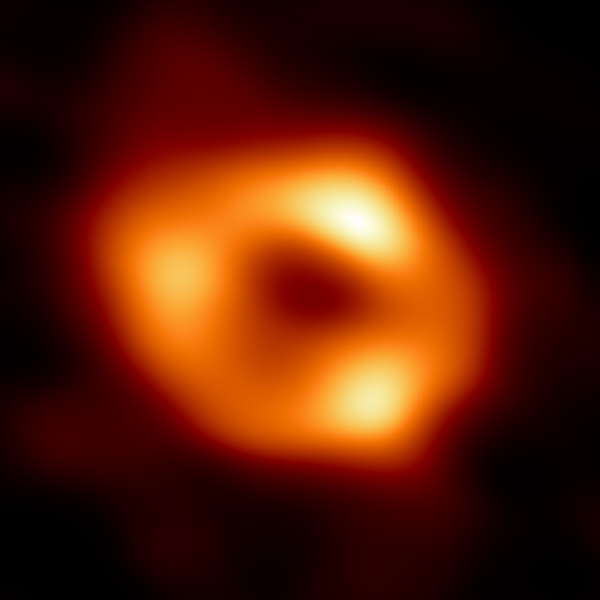Cosmic Curiosities
“The sun, with all those planets revolving around it and dependent on it, can still ripen a bunch of grapes as if it had nothing else in the universe to do.”
- Galileo Galilei
2025 Sky & Space Calendar

Mercury makes its best evening appearances in early March and late June/early July. For morning watchers, the best time to catch the smallest planet is mid-August.
Venus is crazy bright in the evening sky from the start of 2025 until mid-March. It quickly reappears in the morning sky by late March/early April. It remains easily visible in the pre-dawn sky until mid-November.
Mars is at opposition on January 15—meaning it’s closest to Earth and bright in the sky—outshining any nighttime star. Mars stays visible in the evening sky all the way to October’s end.
Jupiter stays bright in the evening sky all the way to early June. By mid-July, the king planet returns in the morning sky. By November, Jupiter returns to the evening sky.
Saturn hangs on in the evening sky for the first two months and then switches to the morning sky in mid-April.
Click here to view the full 2025 Sky and Space Calendar:
Cozying up to the Sun
This time of year, it feels like the sun has abandoned us! Our shortest day of the year, the winter solstice on December 21, only gives us nine hours of sunlight (7:20 a.m. to 4:20 p.m. CDT in Milwaukee).
The reason is simple: Earth is tilted. As we orbit around the sun, Earth’s surface receives different amounts of insolation, or exposure to the sun’s rays. Curiously, Earth’s northern hemisphere begins its winter when the Earth is near its closest approach to the sun!

Credit: NASA
Of course, “closest approach” is relative. On January 4, Earth will be at perihelion, at 91.4 million miles away. In contrast, aphelion, or the farthest point of Earth’s orbit, happens in early July, when our planet is 94.5 million miles away from our star. A good mnemonic to remember the difference is “A=away, per=near.” These facts prove the Earth’s distance to the sun is not the major factor affecting climate and seasons. Rather, weather’s major cause is the tilt of our axis and varied exposure to the sun’s rays throughout the year!
NASA’s Parker Solar Probe
While Earth orbits a little closer to our boiling hot sun at perihelion, there is a spacecraft from Earth that just flew extremely close! Recently, on December 24, NASA’s Parker Solar Probe soared within 3.8 million miles of the solar surface —the closest solar approach in history! Its speed was 430,000 miles per hour, or 120 miles per second, the fastest any humanmade object ever has traveled. Parker’s mission focuses on analyzing the sun’s outer corona. Parker is designed to dive into the upper atmosphere to study the heating of coronal plasma and the dynamics of the sun’s magnetic field, as well as the acceleration of the solar wind.

Credits: NASA/Johns Hopkins APL/Naval Research Laboratory/Guillermo Stenborg and Brendan Gallagher
To adjust its trajectory and boost its acceleration, Parker has done multiple gravity-assist flybys of Venus. Scientists had a pleasant surprise on the third flyby back in 2020. They turned Parker’s Wide-Field Imager (WISPR) onto Venus to track changes in its cloud cover. This camera actually saw through Venus’ thick clouds, capturing a rare glimpse of its 900-degree surface below in near-infrared and visible light.
“Parker continues to outperform our expectations, and we are excited that these novel observations taken during our gravity assist maneuver can help advance Venus research in unexpected ways,” said Dr. Nicola Fox, former director for NASA’s Heliophysics division.
As we endure January and slowly warm up this spring and summer, Parker will, too! It is scheduled for its last two close passes by the sun in March and June of 2025. Thanks, Parker, for furthering our knowledge about the sun and inner solar system!
A Black Hole by Any Other Name…
…will still have ferocious gravity.
Credit: NASA
Did you know black holes used to be called “frozen stars”? Did you know an active galactic nucleus, a quasar, and a blazar are also black holes? Let’s dig a deeper hole into this cosmic nomenclature.
First, let’s define a black hole: Black holes are mysterious objects with infinite density at their singularity—their center. Gravity is so commanding at a black hole that nothing, not even light, can escape once it passes the event horizon—its outer edge. We detect them by the immense energy that is radiated outside the event horizon.
Just over a 100 years ago, after Einstein’s new theory of gravity, or general relativity, a black hole was theorized and called a frozen star. Physicist Karl Schwarzschild coined the name due to the apparent freezing of light at the event horizon of a star with colossal gravity. Our familiar black hole term was devised by astronomer John Wheeler in 1967.

Credit: Astronomy Magazine, Roen Kelly
There are two main classes of black holes: stellar-mass and supermassive. Stellar black holes form when a giant star can’t generate enough energy to support itself against gravity and collapses in on itself. It compacts into a point of infinite density. The resulting black hole will have the mass of the original star. It’s estimated that there're millions of stellar black holes throughout our galaxy.
Supermassive black holes are found at the center of major galaxies. They range from thousands to billions of solar masses, and their formation is still a mystery in astrophysics.
If the black hole is accumulating mass, like at the center of our Milky Way galaxy, it is through a very inefficient process called accretion. Gas is pulled into orbit around the black hole and forms an accretion disk. Friction causes the gas to heat up intensely and radiate a lot of light as it spirals inward. This makes the accretion disk extremely bright—enough so to take photos! The image below is by the Event Horizon Telescope, which is actually an array of eight radio observatories linked together across our planet.

Supermassive Black Hole at the Core of the Milky Way Galaxy; Credit: Events Horizon Telescope
When a supermassive black hole at the center of a galaxy is accreting (consuming matter), it’s called an active galactic nucleus, or AGN. The most luminous AGNs are called quasars. They are more than a trillion times brighter than the sun and even outshine entire galaxies. Some AGNs also eject astrophysical jets—beams of ionized particles shot into space at close to the speed of light along their axis of rotation. Not all quasars have jets, but if they do, it’ll be the brightest component, so it’s easiest to observe the quasars with jets that are pointed toward Earth, which are called blazars.
WHY ARE BLACK HOLES MESSY EATERS?
Despite their immense gravity, most black holes are not always consuming every little thing that wanders by. They are more like messy eaters!
Recall, a black hole can only trap stuff that crosses its event horizon. We tend to think of black holes as these enormous things, but stellar black holes are roughly the size of a large city. Even supermassive black holes are typically smaller than our solar system. So, both black holes are relatively small targets on cosmic scales.
There also may not be much material nearby for them to feed on. Anything that does get close to the black hole will be accelerated to such high speeds that, unless it is aimed directly at the black hole, it’ll miss the event horizon and go into safe and distant orbit around the black hole. Think of this material as throwaway leftovers: If you had to eat your dinner by having it dropped from a plane directly into your mouth, you would be a messy eater, too!
A supermassive black hole’s intense, swirling gravity causes hot material to shoot out at high velocity (near the speed of light) from the top and bottom of these galactic centers. The powerful jets can extend many thousands of light years into space, straight from the galaxies they came from. I guess this could be like expelling our food if it went down the wrong way!
So, in summary, most black holes are stellar black holes. Supermassive black holes are found at galactic centers, and if they’re accreting, they’re called Active Galactic Nuclei. Super bright AGNs are called quasars, and a blazar is a quasar with a jet that’s pointed towards Earth.
Space in Sixty Seconds
See the Mars Illusion in the January 2025 sky!
Sky Sights
The Moon, Venus, and Saturn pair up twice this month. Watch the celestial trio from January 1 through 4 and then again at month’s end from January 30 to February 1.
Jupiter still shines bright in Taurus the Bull this month. Watch the king planet’s position slightly change with the red star Aldebaran. The Moon orbits by on January 9 to 11.
Mars rises about four hours after sunset in early December and only 1.5 hours at month’s end. The Moon nears the red planet from December 17 and 18.
Observe Venus and Saturn switch places in the southwest sky. From January 15 through 19, see how faster Venus slowly overtakes Saturn from our vantage point.
Mercury is out of sight—too near the sun—all month.
January Star Map
Sign Up
Receive this newsletter via email!
Subscribe
See the Universe through a telescope
Join one of the Milwaukee-area astronomy clubs and spot craters on the Moon, the rings of Saturn, the moons of Jupiter, and much more.
Follow Bob on social media
Twitter: @MPMPlanetarium
Facebook: Daniel M. Soref Planetarium






